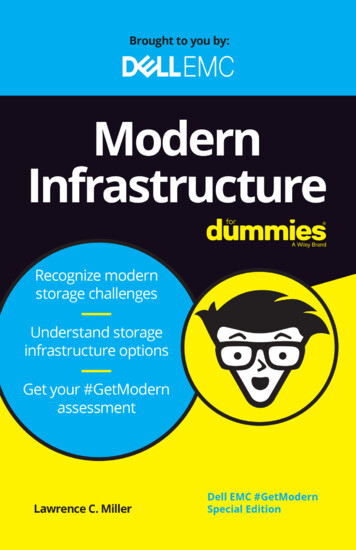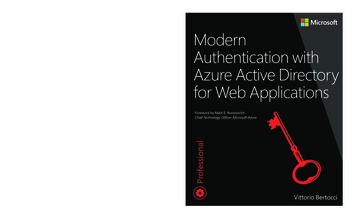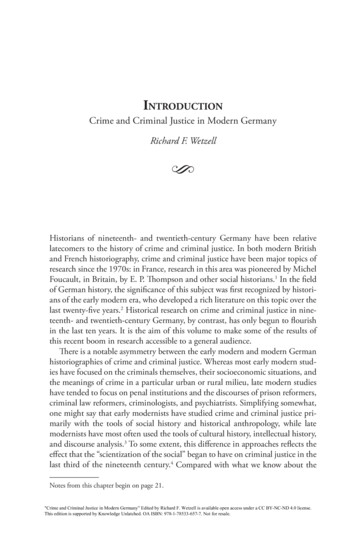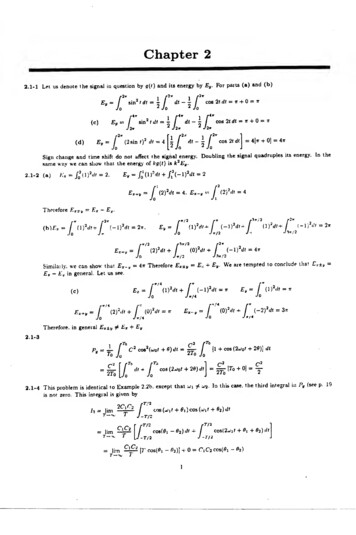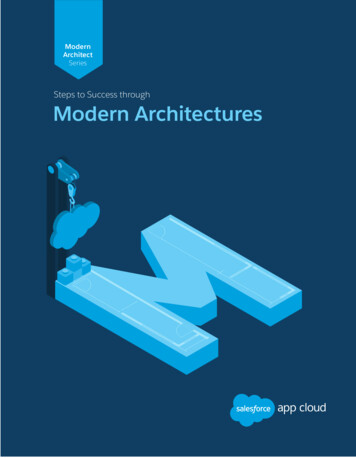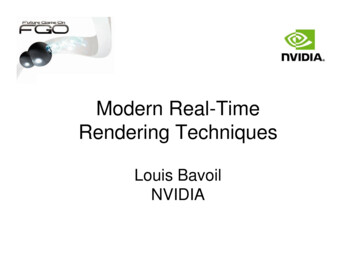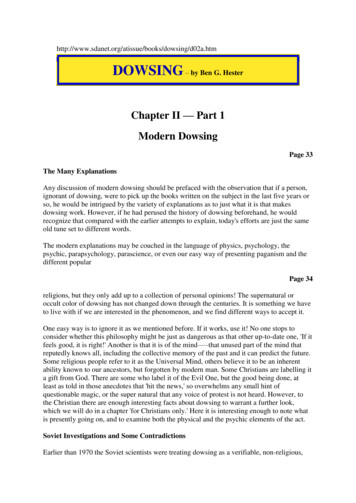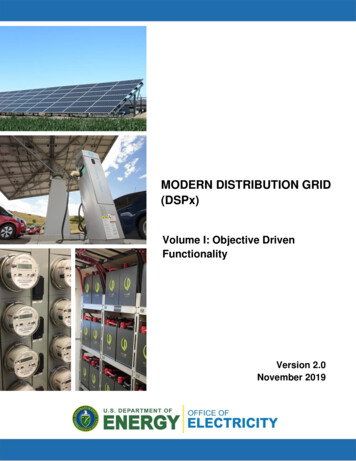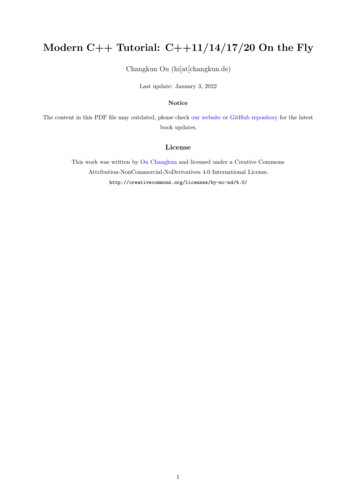
Transcription
Modern C Tutorial: C 11/14/17/20 On the FlyChangkun Ou (hi[at]changkun.de)Last update: January 3, 2022NoticeThe content in this PDF file may outdated, please check our website or GitHub repository for the latestbook updates.LicenseThis work was written by Ou Changkun and licensed under a Creative CommonsAttribution-NonCommercial-NoDerivatives 4.0 International nd/4.0/1
2
CONTENTSCONTENTSContentsPreface8Introduction . . . . . . . . . . . . . . . . . . . . . . . . . . . . . . . . . . . . . . . . . . . . . . .8Targets . . . . . . . . . . . . . . . . . . . . . . . . . . . . . . . . . . . . . . . . . . . . . . . . .8Purpose . . . . . . . . . . . . . . . . . . . . . . . . . . . . . . . . . . . . . . . . . . . . . . . . .9Code . . . . . . . . . . . . . . . . . . . . . . . . . . . . . . . . . . . . . . . . . . . . . . . . . . .9Exercises . . . . . . . . . . . . . . . . . . . . . . . . . . . . . . . . . . . . . . . . . . . . . . . .9Chapter 01: Towards Modern C 91.1 Deprecated Features . . . . . . . . . . . . . . . . . . . . . . . . . . . . . . . . . . . . . . . . 101.2 Compatibilities with C . . . . . . . . . . . . . . . . . . . . . . . . . . . . . . . . . . . . . . . 11Further Readings . . . . . . . . . . . . . . . . . . . . . . . . . . . . . . . . . . . . . . . . . . . . 13Chapter 02: Language Usability Enhancements132.1 Constants . . . . . . . . . . . . . . . . . . . . . . . . . . . . . . . . . . . . . . . . . . . . . . 13nullptr . . . . . . . . . . . . . . . . . . . . . . . . . . . . . . . . . . . . . . . . . . . . . . . 13constexpr . . . . . . . . . . . . . . . . . . . . . . . . . . . . . . . . . . . . . . . . . . . . . 152.2 Variables and initialization . . . . . . . . . . . . . . . . . . . . . . . . . . . . . . . . . . . . 17if-switch . . . . . . . . . . . . . . . . . . . . . . . . . . . . . . . . . . . . . . . . . . . . . . 17Initializer list . . . . . . . . . . . . . . . . . . . . . . . . . . . . . . . . . . . . . . . . . . . 18Structured binding . . . . . . . . . . . . . . . . . . . . . . . . . . . . . . . . . . . . . . . . 202.3 Type inference . . . . . . . . . . . . . . . . . . . . . . . . . . . . . . . . . . . . . . . . . . . 20auto . . . . . . . . . . . . . . . . . . . . . . . . . . . . . . . . . . . . . . . . . . . . . . . . 20decltype . . . . . . . . . . . . . . . . . . . . . . . . . . . . . . . . . . . . . . . . . . . . . . 22tail type inference. . . . . . . . . . . . . . . . . . . . . . . . . . . . . . . . . . . . . . . . 23decltype(auto) . . . . . . . . . . . . . . . . . . . . . . . . . . . . . . . . . . . . . . . . . . 242.4 Control flow . . . . . . . . . . . . . . . . . . . . . . . . . . . . . . . . . . . . . . . . . . . . . 25if constexpr . . . . . . . . . . . . . . . . . . . . . . . . . . . . . . . . . . . . . . . . . . . . 25Range-based for loop . . . . . . . . . . . . . . . . . . . . . . . . . . . . . . . . . . . . . . . 252.5 Templates . . . . . . . . . . . . . . . . . . . . . . . . . . . . . . . . . . . . . . . . . . . . . . 263
CONTENTSCONTENTSExtern templates . . . . . . . . . . . . . . . . . . . . . . . . . . . . . . . . . . . . . . . . . 26The “ ” . . . . . . . . . . . . . . . . . . . . . . . . . . . . . . . . . . . . . . . . . . . . . . 26Type alias templates . . . . . . . . . . . . . . . . . . . . . . . . . . . . . . . . . . . . . . . 27Variadic templates . . . . . . . . . . . . . . . . . . . . . . . . . . . . . . . . . . . . . . . . 28Fold expression . . . . . . . . . . . . . . . . . . . . . . . . . . . . . . . . . . . . . . . . . . 30Non-type template parameter deduction . . . . . . . . . . . . . . . . . . . . . . . . . . . . 312.6 Object-oriented . . . . . . . . . . . . . . . . . . . . . . . . . . . . . . . . . . . . . . . . . . . 32Delegate constructor . . . . . . . . . . . . . . . . . . . . . . . . . . . . . . . . . . . . . . . 32Inheritance constructor. . . . . . . . . . . . . . . . . . . . . . . . . . . . . . . . . . . . . 32Explicit virtual function overwrite . . . . . . . . . . . . . . . . . . . . . . . . . . . . . . . 33override . . . . . . . . . . . . . . . . . . . . . . . . . . . . . . . . . . . . . . . . . . . . . . 33final . . . . . . . . . . . . . . . . . . . . . . . . . . . . . . . . . . . . . . . . . . . . . . . . 34Explicit delete default function . . . . . . . . . . . . . . . . . . . . . . . . . . . . . . . . . 34Strongly typed enumerations . . . . . . . . . . . . . . . . . . . . . . . . . . . . . . . . . . 35Conclusion . . . . . . . . . . . . . . . . . . . . . . . . . . . . . . . . . . . . . . . . . . . . . . . 36Exercises . . . . . . . . . . . . . . . . . . . . . . . . . . . . . . . . . . . . . . . . . . . . . . . . 36Chapter 03: Language Runtime Enhancements373.1 Lambda Expression . . . . . . . . . . . . . . . . . . . . . . . . . . . . . . . . . . . . . . . . 37Basics . . . . . . . . . . . . . . . . . . . . . . . . . . . . . . . . . . . . . . . . . . . . . . . 37Generic Lambda . . . . . . . . . . . . . . . . . . . . . . . . . . . . . . . . . . . . . . . . . 393.2 Function Object Wrapper . . . . . . . . . . . . . . . . . . . . . . . . . . . . . . . . . . . . . 39std::function . . . . . . . . . . . . . . . . . . . . . . . . . . . . . . . . . . . . . . . . . . 39std::bind and std::placeholder . . . . . . . . . . . . . . . . . . . . . . . . . . . . . . . 413.3 rvalue Reference . . . . . . . . . . . . . . . . . . . . . . . . . . . . . . . . . . . . . . . . . . 41lvalue, rvalue, prvalue, xvalue . . . . . . . . . . . . . . . . . . . . . . . . . . . . . . . . . . 41rvalue reference and lvalue reference . . . . . . . . . . . . . . . . . . . . . . . . . . . . . . 43Move semantics . . . . . . . . . . . . . . . . . . . . . . . . . . . . . . . . . . . . . . . . . . 44Perfect forwarding . . . . . . . . . . . . . . . . . . . . . . . . . . . . . . . . . . . . . . . . 46Conclusion . . . . . . . . . . . . . . . . . . . . . . . . . . . . . . . . . . . . . . . . . . . . . . . 494
CONTENTSCONTENTSFurther Readings . . . . . . . . . . . . . . . . . . . . . . . . . . . . . . . . . . . . . . . . . . . . 49Chapter 04 Containers504.1 Linear Container . . . . . . . . . . . . . . . . . . . . . . . . . . . . . . . . . . . . . . . . . . 50std::array . . . . . . . . . . . . . . . . . . . . . . . . . . . . . . . . . . . . . . . . . . . . 50std::forward list . . . . . . . . . . . . . . . . . . . . . . . . . . . . . . . . . . . . . . . 524.2 Unordered Container . . . . . . . . . . . . . . . . . . . . . . . . . . . . . . . . . . . . . . . . 524.3 Tuples . . . . . . . . . . . . . . . . . . . . . . . . . . . . . . . . . . . . . . . . . . . . . . . . 53Basic Operations . . . . . . . . . . . . . . . . . . . . . . . . . . . . . . . . . . . . . . . . . 54Runtime Indexing . . . . . . . . . . . . . . . . . . . . . . . . . . . . . . . . . . . . . . . . . 55Merge and Iteration . . . . . . . . . . . . . . . . . . . . . . . . . . . . . . . . . . . . . . . 56Conclusion . . . . . . . . . . . . . . . . . . . . . . . . . . . . . . . . . . . . . . . . . . . . . . . 56Chapter 05 Smart Pointers and Memory Management565.1 RAII and Reference Counting . . . . . . . . . . . . . . . . . . . . . . . . . . . . . . . . . . . 565.2 std::shared ptr . . . . . . . . . . . . . . . . . . . . . . . . . . . . . . . . . . . . . . . . . 575.3 std::unique ptr . . . . . . . . . . . . . . . . . . . . . . . . . . . . . . . . . . . . . . . . . 585.4 std::weak ptr . . . . . . . . . . . . . . . . . . . . . . . . . . . . . . . . . . . . . . . . . . . 60Conclusion . . . . . . . . . . . . . . . . . . . . . . . . . . . . . . . . . . . . . . . . . . . . . . . 62Further Readings . . . . . . . . . . . . . . . . . . . . . . . . . . . . . . . . . . . . . . . . . . . . 62Chapter 06 Regular Expression626.1 Introduction . . . . . . . . . . . . . . . . . . . . . . . . . . . . . . . . . . . . . . . . . . . . 62Ordinary characters . . . . . . . . . . . . . . . . . . . . . . . . . . . . . . . . . . . . . . . 62Special characters . . . . . . . . . . . . . . . . . . . . . . . . . . . . . . . . . . . . . . . . . 62Quantifiers . . . . . . . . . . . . . . . . . . . . . . . . . . . . . . . . . . . . . . . . . . . . 636.2 std::regex and Its Related . . . . . . . . . . . . . . . . . . . . . . . . . . . . . . . . . . . . 64Conclusion . . . . . . . . . . . . . . . . . . . . . . . . . . . . . . . . . . . . . . . . . . . . . . . 65Exercise . . . . . . . . . . . . . . . . . . . . . . . . . . . . . . . . . . . . . . . . . . . . . . . . . 65Further Readings . . . . . . . . . . . . . . . . . . . . . . . . . . . . . . . . . . . . . . . . . . . . 67Chapter 07 Parallelism and Concurrency675
CONTENTSCONTENTS7.1 Basic of Parallelism . . . . . . . . . . . . . . . . . . . . . . . . . . . . . . . . . . . . . . . . 677.2 Mutex and Critical Section . . . . . . . . . . . . . . . . . . . . . . . . . . . . . . . . . . . . 687.3 Future . . . . . . . . . . . . . . . . . . . . . . . . . . . . . . . . . . . . . . . . . . . . . . . . 707.4 Condition Variable . . . . . . . . . . . . . . . . . . . . . . . . . . . . . . . . . . . . . . . . . 717.5 Atomic Operation and Memory Model . . . . . . . . . . . . . . . . . . . . . . . . . . . . . . 73Atomic Operation . . . . . . . . . . . . . . . . . . . . . . . . . . . . . . . . . . . . . . . . 74Consistency Model . . . . . . . . . . . . . . . . . . . . . . . . . . . . . . . . . . . . . . . . 75Memory Orders . . . . . . . . . . . . . . . . . . . . . . . . . . . . . . . . . . . . . . . . . . 78Conclusion . . . . . . . . . . . . . . . . . . . . . . . . . . . . . . . . . . . . . . . . . . . . . . . 80Exercises . . . . . . . . . . . . . . . . . . . . . . . . . . . . . . . . . . . . . . . . . . . . . . . . 80Further Readings . . . . . . . . . . . . . . . . . . . . . . . . . . . . . . . . . . . . . . . . . . . . 81Chapter 08 File System818.1 Document and Link . . . . . . . . . . . . . . . . . . . . . . . . . . . . . . . . . . . . . . . . 818.2 std::filesystem . . . . . . . . . . . . . . . . . . . . . . . . . . . . . . . . . . . . . . . . . . . . 81Further Readings . . . . . . . . . . . . . . . . . . . . . . . . . . . . . . . . . . . . . . . . . . . . 81Chapter 09 Minor Features819.1 New Type . . . . . . . . . . . . . . . . . . . . . . . . . . . . . . . . . . . . . . . . . . . . . . 81long long int . . . . . . . . . . . . . . . . . . . . . . . . . . . . . . . . . . . . . . . . . . 819.2 noexcept and Its Operations . . . . . . . . . . . . . . . . . . . . . . . . . . . . . . . . . . . 829.3 Literal . . . . . . . . . . . . . . . . . . . . . . . . . . . . . . . . . . . . . . . . . . . . . . . . 83Raw String Literal . . . . . . . . . . . . . . . . . . . . . . . . . . . . . . . . . . . . . . . . 83Custom Literal . . . . . . . . . . . . . . . . . . . . . . . . . . . . . . . . . . . . . . . . . . 849.4 Memory Alignment . . . . . . . . . . . . . . . . . . . . . . . . . . . . . . . . . . . . . . . . . 84Conclusion . . . . . . . . . . . . . . . . . . . . . . . . . . . . . . . . . . . . . . . . . . . . . . . 85Chapter 10 Outlook: Introduction of C 2085Concept . . . . . . . . . . . . . . . . . . . . . . . . . . . . . . . . . . . . . . . . . . . . . . . . . 86Module . . . . . . . . . . . . . . . . . . . . . . . . . . . . . . . . . . . . . . . . . . . . . . . . . 87Contract . . . . . . . . . . . . . . . . . . . . . . . . . . . . . . . . . . . . . . . . . . . . . . . . . 876
CONTENTSCONTENTSRange . . . . . . . . . . . . . . . . . . . . . . . . . . . . . . . . . . . . . . . . . . . . . . . . . . 87Coroutine . . . . . . . . . . . . . . . . . . . . . . . . . . . . . . . . . . . . . . . . . . . . . . . . 87Conclusion . . . . . . . . . . . . . . . . . . . . . . . . . . . . . . . . . . . . . . . . . . . . . . . 87Further Readings . . . . . . . . . . . . . . . . . . . . . . . . . . . . . . . . . . . . . . . . . . . . 87Appendix 1: Further Study Materials87Appendix 2: Modern C Best Practices88Common Tools . . . . . . . . . . . . . . . . . . . . . . . . . . . . . . . . . . . . . . . . . . . . . 88Coding Style . . . . . . . . . . . . . . . . . . . . . . . . . . . . . . . . . . . . . . . . . . . . . . 88Overall Performance . . . . . . . . . . . . . . . . . . . . . . . . . . . . . . . . . . . . . . . . . . 88Code Security . . . . . . . . . . . . . . . . . . . . . . . . . . . . . . . . . . . . . . . . . . . . . . 88Maintainability . . . . . . . . . . . . . . . . . . . . . . . . . . . . . . . . . . . . . . . . . . . . . 88Portability . . . . . . . . . . . . . . . . . . . . . . . . . . . . . . . . . . . . . . . . . . . . . . . . 887
PREFACEPrefaceIntroductionThe C programming language owns a fairly large user group. From the advent of C 98 to theofficial finalization of C 11, it has continued to stay relevant. C 14/17 is an important complementand optimization for C 11, and C 20 brings this language to the door of modernization. Theextended features of all these new standards are integrated into the C language and infuse it withnew vitality. C programmers who are still using traditional C (this book refers to C 98 andits previous standards as traditional C ) may even amazed by the fact that they are not using thesame language while reading modern C code.Modern C (this book refers to C 11/14/17/20) introduces many features into traditionalC which bring the entire language to a new level of modernization. Modern C not only enhancesthe usability of the C language itself, but the modification of the auto keyword semantics gives us moreconfidence in manipulating extremely complex template types. At the same time, a lot of enhancementshave been made to the language runtime. The emergence of Lambda expressions has given C the“closure” feature of “anonymous functions”, which are in almost all modern programming languages (suchas Python, Swift, etc). It has become commonplace, and the emergence of rvalue references has solvedthe problem of temporary object efficiency that C has long been criticized for.C 17 is the direction that has been promoted by the C community in the past three years. Italso points out an important development direction of modern C programming. Although it doesnot appear as much as C 11, it contains a large number of small and beautiful languages and features(such as structured binding), and the appearance of these features once again corrects our programmingparadigm in C .Modern C also adds a lot of tools and methods to its standard library such as std::thread atthe level of the language itself, which supports concurrent programming and no longer depends on theunderlying system on different platforms. The API implements cross-platform support at the languagelevel; std::regex provides full regular expression support and more. C 98 has been proven to be avery successful “paradigm”, and the emergence of modern C further promotes this paradigm, makingC a better language for system programming and library development. Concepts verify the compiletime of template parameters, further enhancing the usability of the language.In conclusion, as an advocate and practitioner of C , we always maintain an open mind to acceptnew things, and we can promote the development of C faster, making this old and novel languagemore vibrant.Targets This book assumes that readers are already familiar with traditional C (i.e. C 98 or earlier),at least they do not have any difficulty in reading traditional C code. In other words, those whohave long experience in traditional C and people who desire to quickly understand the features8
PurposeCHAPTER 01: TOWARDS MODERN C of modern C in a short period are well suited to read the book; This book introduces to a certain extent of the dark magic of modern C . However, these magicsare very limited, they are not suitable for readers who want to learn advanced C . The purposeof this book is to offer a quick start for modern C . Of course, advanced readers can also usethis book to review and examine themselves on modern C .PurposeThe book claims “On the Fly”. It intends to provide a comprehensive introduction to the relevantfeatures regarding modern C (before the 2020s). Readers can choose interesting content according tothe following table of contents to learn and quickly familiarize themselves with the new features that areavailable. Readers should aware that all of these features are not required. It should be learned whenyou need it.At the same time, instead of grammar-only, the book introduces the historical background as simpleas possible of its technical requirements, which provides great help in understanding why these featurescome out.Also, the author would like to encourage that readers should be able to use modern C directlyin their new projects and migrate their old projects to modern C gradually after reading the book.CodeEach chapter of this book has a lot of code. If you encounter problems when writing your own codewith the introductory features of the book, you might as well read the source code attached to the book.You can find the book here. All the code is organized by chapter, the folder name is the chapter number.ExercisesThere are few exercises At the end of each chapter of the book. It is for testing whether you canuse the knowledge points in the current chapter. You can find the possible answer to the problem fromhere. The folder name is the chapter number.Chapter 01: Towards Modern C Compilation Environment: This book will use clang as the only compiler used, and alwaysuse the -std c 2a compilation flag in your code. clang -vApple LLVM version 10.0.1 (clang-1001.0.46.4)Target: x86 64-apple-darwin18.6.09
1.1 Deprecated FeaturesCHAPTER 01: TOWARDS MODERN C Thread model: posixInstalledDir: /Library/Developer/CommandLineTools/usr/bin1.1 Deprecated FeaturesBefore learning modern C , let’s take a look at the main features that have deprecated sinceC 11:Note: Deprecation is not completely unusable, it is only intended to imply that features willdisappear from future standards and should be avoided. But, the deprecated features are stillpart of the standard library, and most of the features are actually “permanently” reservedfor compatibility reasons. The string literal constant is no longer allowed to be assigned to a char *. If you needto assign and initialize a char * with a string literal constant, you should use constchar * or auto.char *str "hello world!"; // A deprecation warning will appear C 98 exception description, unexpected handler, set unexpected() and other relatedfeatures are deprecated and should use noexcept. auto ptr is deprecated and unique ptr should be used. register keyword is deprecated and can be used but no longer has any practicalmeaning. The operation of the bool type is deprecated. If a class has a destructor, the properties for which it generates copy constructors andcopy assignment operators are deprecated. C language style type conversion is deprecated (ie using (convert type)) before variables, and static cast, reinterpret cast, const cast should be used for type conversion. In particular, some of the C standard libraries that can be used are deprecated inthe latest C 17 standard, such as ccomplex , cstdalign , cstdbool and ctgmath Wait and many moreThere are also other features such as parameter binding (C 11 provides std::bind andstd::function), export etc. are also deprecated. These features mentioned above If you have neverused or heard of it, please don’t try to understand them. You should move closer to thenew standard and learn new features directly. After all, technology is moving forward.10
1.2 Compatibilities with CCHAPTER 01: TOWARDS MODERN C Figure 1: Figure 1.2: Compatabilities between ISO C and ISO C 1.2 Compatibilities with CFor some force majeure and historical reasons, we had to use some C code (even old C code) in C ,for example, Linux system calls. Before the advent of modern C , most people talked about “what isthe difference between C and C ”. Generally speaking, in addition to answering the object-orientedclass features and the template features of generic programming, there is no other opinion or even adirect answer. “Almost” is also a lot of people. The Venn diagram in Figure 1.2 roughly answers the Cand C related compatibility.From now on, you should have the idea that “C is not a superset of C” in your mind (andnot from the beginning, later References for further reading The difference between C 98 and C99 isgiven). When writing C , you should also avoid using program styles such as void* whenever possible.When you have to use C, you should pay attention to the use of extern "C", separate the C languagecode from the C code, and then unify the link, for instance:// foo.h#ifdef cplusplusextern "C" {#endifint add(int x, int y);#ifdef cplusplus11
1.2 Compatibilities with CCHAPTER 01: TOWARDS MODERN C }#endif// foo.cint add(int x, int y) {return x y;}// 1.1.cpp#include "foo.h"#include iostream #include functional int main() {[out std::ref(std::cout "Result from C code: " add(1, 2))](){out.get() ".\n";}();return 0;}You should first compile the C code with gcc:gcc -c foo.cCompile and output the foo.o file, and link the C code to the .o file using clang (or bothcompile to .o and then link them together):clang 1.1.cpp foo.o -std c 2a -o 1.1Of course, you can use Makefile to compile the above code:C gccCXX clang SOURCE C foo.cOBJECTS C foo.oSOURCE CXX 1.1.cppTARGET 1.1LDFLAGS COMMON -std c 2a12
Further ReadingsCHAPTER 02: LANGUAGE USABILITY ENHANCEMENTSall: (C) -c (SOURCE C) (CXX) (SOURCE CXX) (OBJECTS C) (LDFLAGS COMMON) -o (TARGET)clean:rm -rf *.o (TARGET)Note: Indentation in Makefile is a tab instead of a space character. If you copy thiscode directly into your editor, the tab may be automatically replaced. Please ensure theindentation in the Makefile is done by tabs.If you don’t know the use of Makefile, it doesn’t matter. In this tutorial, you won’t buildcode that is written too complicated. You can also read this book by simply using clang -std c 2a on the command line.If you are new to modern C , you probably still don’t understand the following small piece ofcode above, namely:[out std::ref(std::cout "Result from C code: " add(1, 2))](){out.get() ".\n";}();Don’t worry at the moment, we will come to meet them in our later chapters.Further Readings A Tour of C (2nd Edition) Bjarne Stroustrup History of C C compiler support Incompatibilities Between ISO C and ISO C Chapter 02: Language Usability EnhancementsWhen we declare, define a variable or constant, and control the flow of code, object-oriented functions,template programming, etc., before the runtime, it may happen when writing code or compiler compilingcode. To this end, we usually talk about language usability, which refers to the language behaviorthat occurred before the runtime.2.1 ConstantsnullptrThe purpose of nullptr appears to replace NULL. In a sense, traditional C treats NULL and 0as the same thing, depending on how the compiler defines NULL, and some compilers define NULL as13
2.1 ConstantsCHAPTER 02: LANGUAGE USABILITY ENHANCEMENTS((void*)0) Some will define it directly as 0.C does not allow to implicitly convert void * to other types. But if the compiler tries todefine NULL as ((void*)0), then in the following code:char *ch NULL;C without the void * implicit conversion has to define NULL as 0. This still creates a newproblem. Defining NULL to 0 will cause the overloading feature in C to be confusing. Consider thefollowing two foo functions:void foo(char*);void foo(int);Then the foo(NULL); statement will call foo(int), which will cause the code to be counterintuitive.To solve this problem, C 11 introduced the nullptr keyword, which is specifically used to distinguish null pointers, 0. The type of nullptr is nullptr t, which can be implicitly converted to anypointer or member pointer type, and can be compared equally or unequally with them.You can try to compile the following code using clang :#include iostream #include type traits void foo(char *);void foo(int);int main() {if (std::is same decltype(NULL), decltype(0) ::value)std::cout "NULL 0" std::endl;if (std::is same decltype(NULL), decltype((void*)0) ::value)std::cout "NULL (void *)0" std::endl;if (std::is same decltype(NULL), std::nullptr t ::value)std::cout "NULL nullptr" std::endl;foo(0);// will call foo(int)// foo(NULL);// doesn't compilefoo(nullptr);// will call foo(char*)return 0;}void foo(char *) {std::cout "foo(char*) is called" std::endl;14
2.1 ConstantsCHAPTER 02: LANGUAGE USABILITY ENHANCEMENTS}void foo(int i) {std::cout "foo(int) is called" std::endl;}The outputs are:foo(int) is calledfoo(char*) is calledFrom the output we can see that NULL is different from 0 and nullptr. So, develop the habit ofusing nullptr directly.In addition, in the above code, we used decltype and std::is same which are modern C syntax.In simple terms, decltype is used for type derivation, and std::is same is used to compare the equalityof the two types. We will discuss them in detail later in the decltype section.constexprC itself already has the concept of constant expressions, such as 1 2, 3*4. Such expressionsalways produce the same result without any side effects. If the compiler can directly optimize and embedthese expressions into the program at compile-time, it will increase the performance of the program. Avery obvious example is in the definition phase of an array:#include iostream #define LEN 10int len foo() {int i 2;return i;}constexpr int len foo constexpr() {return 5;}constexpr int fibonacci(const int n) {return n 1 n 2 ? 1 : fibonacci(n-1) fibonacci(n-2);}int main() {char arr 1[10];// legalchar arr 2[LEN];// legal15
2.1 ConstantsCHAPTER 02: LANGUAGE USABILITY ENHANCEMENTSint len 10;// char arr 3[len];// illegalconst int len 2 len 1;constexpr int len 2 constexpr 1 2 3;// char arr 4[len 2];// illegal, but ok for most of the compilerschar arr 4[len 2 constexpr];// legal// char arr 5[len foo() 5];// illegalchar arr 6[len foo constexpr() 1]; // legal// 1, 1, 2, 3, 5, 8, 13, 21, 34, 55std::cout fibonacci(10) std::endl;return 0;}In the above example, char arr 4[len 2] may be confusing because len 2 has been defined asa constant. Why is char arr 4[len 2] still illegal? This is because the length of the array in theC standard must be a constant expression, and for len 2, this is a const constant, not a constantexpression, so even if this behavior is supported by most compilers, but it is an illegal behavior, we needto use the constexpr feature introduced in C 11, which will be introduced next, to solve this problem;for arr 5, before C 98 The compiler cannot know that len foo() actually returns a constant atruntime, which causes illegal production.Note that most compilers now have their compiler optimizations. Many illegal behaviorsbecome legal under the compiler’s optimization. If you need to reproduce the error, you needto use the old version of the compiler.C 11 provides constexpr to let the user explicitly declare that the function or object constructorwill become a constant expression at compile time. This keyword explicitly tells the compiler that itshould verify that len foo should be a compile-time constant expression. Constant expression.In addition, the function of constexpr can use recursion:constexpr int fibonacci(const int n) {return n 1 n 2 ? 1 : fibonacci(n-1) fibonacci(n-2);}Starting with C 14, the constexpr function can use simple statements such as local variables,loops, and branches internally. For example, the following code cannot be compiled under the C 11standard:16
2.2 Variables and initializationCHAPTER 02: LANGUAGE USABILITY ENHANCEMENTSconstexpr int fibonacci(const int n) {if(n 1) return 1;if(n 2) return 1;return fibonacci(n-1) fibonacci(n-2);}To do this, we can write a simplified version like this to make the function available from C 11:constexpr int fibonacci(const int n) {return n 1 n 2 ? 1 : fibonacci(n-1) fibonacci(n-2);}2.2 Variables and initializationif-switchIn traditional C , the declaration of a variable can declare a temporary variable int even though itcan be located anywhere, even within a for statement, but there is always no way to declare a temporaryvariable in the if and switch statements. E.g:#include iostream #include vector #include algorithm int main() {std::vector int vec {1, 2, 3, 4};// since c 17, can be simplified by using auto const std::vector int ::iterator itr std::find(vec.begin(), vec.end(), 2);if (itr ! vec.end()) {*itr 3;}if (const std::vector int ::iterator itr std::find(vec.begin(), vec.end(), 3);itr ! vec.end()) {*itr 4;}// should output: 1, 4, 3, 4. can be simplified using auto for (std::vector int ::iterator element vec.begin(); element ! vec.end(); element)std::cout *element std::endl;}17
2.2 Variables and initializationCHAPTER 02: LANGUAGE USABILITY ENHANCEMENTSIn the above code, we can see that the itr variable is defined in the scope of the entire main(),which causes us to rename the other when a variable need to traverse the entire std::vectors again.C 17 eliminates this limitation so that we can do this in if(or switch):if (const std::vector int ::iterator itr std::find(vec.begin(), vec.end(), 3);itr ! vec.end()) {*itr 4;}Is it similar to the Go?Initializer listInitialization is a very important language feature, the most common one is when the object isinitialized. In traditional C , different objects have different initialization methods, such as ordinaryarrays, PODs (Plain Old Data, i.e. classes without constructs, destructors, and virtual functions) Orstruct type can be initialized with {}, which is what we call the initialization l
C does not allow to implicitly convert void * to other types. But if the compiler tries to defineNULLas((void*)0),theninthefollowingcode: char *ch NULL; C without the void * implicit conversion has to defineNULL as 0. This still creates a new problem. DefiningNULL to 0 will cause the overloading feature in C to be confusing. Consider the
![Unreal Engine 4 Tutorial Blueprint Tutorial [1] Basic .](/img/5/ue4-blueprints-tutorial-2018.jpg)
